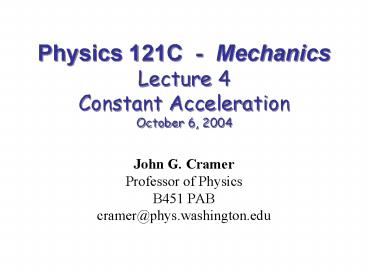Physics 121C Mechanics Lecture 4 Constant Acceleration October 6, 2004 - PowerPoint PPT Presentation
1 / 26
Title:
Physics 121C Mechanics Lecture 4 Constant Acceleration October 6, 2004
Description:
Physics 121C - Mechanics. Lecture 4. Constant Acceleration. October 6, 2004. John G. Cramer ... as = Dvs/Dt = (vfs vis)/Dt; therefore, vfs = vis asDt. ... – PowerPoint PPT presentation
Number of Views:105
Avg rating:3.0/5.0
Title: Physics 121C Mechanics Lecture 4 Constant Acceleration October 6, 2004
1
Physics 121C - MechanicsLecture 4Constant
AccelerationOctober 6, 2004
- John G. Cramer
- Professor of Physics
- B451 PAB
- cramer_at_phys.washington.edu
2
Announcements
You all should have received this E-mail To all
students in Physics 121A, 121C, and 121D The
deadline for the first Tycho homework assignment
has been changed. The due date is now Wednesday,
October 13 at 900 PM (instead of Wed. Oct
6). Also, please note that three of the eight
problems in the first assignment are now marked
"not for credit." These problems may be done but
will not be graded, because they are based on
concepts that appear in later chapters of the
textbook. We apologize for any
inconvenience. Sincerely, Peter Shaffer
3
Lecture Schedule (Part 1)
You are here!
4
Uniformly Accelerated Motion
Rate of velocity change Dvs/Dt (30 m/s)/(6.0
s) 5.0 (m/s)/s 5.0 m/s2
aavg º Dvs/Dt (average acceleration), so aPor avg
5.0 m/s2 (constant)
aVW avg º Dvs/Dt (10 m/s)/(5.0 s) 2.0 m/s2
(constant)
This is uniformly accelerated motion, i.e. motion
with constant acceleration.
5
Running the Court
- A basketball player starts at theleft end of the
court and moveswith the velocity shown below. - What does his motion look like?
- What is his acceleration?
Dv1 (6 m/s) (0 m/s) 6 m/sa1 Dv1/Dt1 (6
m/s)/(6 s) 1.0 m/s2 Dv2 (-6 m/s) (6 m/s)
-12 m/sa2 Dv2/Dt2 (-12 m/s)/(6 s) -2.0
m/s2
6
Kinematic Equations
Motion with constant acceleration as as
Dvs/Dt (vfs vis)/Dt therefore, vfs vis
asDt. sf si (area under velocity curve vs
between ti and tf) si visDt
½as(Dt)2
Dt (vfs vis)/as , so, substituting sf si
vis(vfs vis)/as ½as(vfs vis)/as2 si
(visvfs/as) - (vfs2/as) (vis2/2as)
- (visvfs/as) (vis2/2as) si (vfs2 -
vis2)/as or vfs2 vis2 2asDs
7
Kinematic Equations
8
Motion Summary
9
Rocket Sled
A rocket sled acceleratesat 50 m/s2 for 5.0
s, coastsfor 3.0 s, then deploys abraking
parachute anddecelerates at 3.0 m/s2until
coming to a halt.
- What is the maximumvelocity reached bythe
rocket sled? - v1x v0x a0x(t1 t0) a0xt1
- (50 m/s2)(5.0 s) 250 m/s
(b) What is the total distance traveled bythe
rocket sled? x1 x0 v0x(t1 t0) ½a0x(t1
t0)2 ½a0xt12 ½(50 m/s2)(5.0 s)2 625
m x2 x1 v1x(t2 t1) 625 m (250 m/s)(3.0
s) 1375 m v3x2 v2x2 2a2xDx v2x2 2a2x(x3
x2), so x3 x2 (v3x2 - v2x2)/2a2x 1375 m
0 (250 m/s)2/2(-3.0 m/s2) 11,800 m
10
Clicker Question
Which velocity-vs-time graph goeswith the
acceleration-vs-time graphshown at the right?
11
Free Fall
An object moves in free fall when it
movesunder the influence of uniform gravity, and
noother forces. Strictly speaking, this
happens only in vacuum, but in practice we can
often neglect air resistance and observe this
behavior. a constant acceleration due to
gravity g 9.80 m/s2 ay -g ( -9.80
m/s2) vy - gt y -½g t2
12
A Falling Rock
- A rock is released fromrest at the top of a 100
mtall building. - How long does to takefor the rock to fall to
theground? - y1 y0 - ½gt12 , so
- t1 2(y1 - y0)/g½ 2(100
m)/(9.80 m/s2)½ 4.52 s 4.52 s - What is the impact velocity?
- v1 v0 - gt1 0 (9.80 m/s2)(4.52 s) -44.3
m/s
13
Motion on an Inclined Plane
An frictionless inclined plane can be usedto
dilute the acceleration due to gravity. The
component of g perpendicular to the surface (g
Cosq) is cancelled by the normal forcefrom the
plane. The component of g parallel to the
surface (g Sinq) acts to accelerate the object
down the plane. as g Sinq (depending on
the orientation of the inclined plane).
14
Downhill Skiing
A skiers speed at the bottom of a 100 m slope
is 20 m/s. What is the angleof the slope? v2s2
v1s2 2 as Dx 2 g Sinq Dx, so Sinq v2s2/(2
g Dx) (20 m/s)2/2(9.80 m/s2)(100 m)
0.204 q Sin-1(0.204) 11.8O
15
Ball Rolling on Track
16
Instantaneous Acceleration
17
Velocity from Acceleration
18
Nonuniform Acceleration
19
Clicker Question 2
Rank in order, fromlargest to smallest,the
accelerations at points A, B, and C.
(a) aA gt aB gt aC (b) aC gt aA gt aB (c)
aC gt aB gt aA (d) aB gt aA gt aC
20
Important Concepts
21
End of Lecture 4
- Before the next lecture, read Knight,Chapters
3.1 through 3.4 - Homework Assignment 1 has beenpostponed, and
is not due until 900 PM, Wednesday, Oct. 13. - If you have not already done so, registeryour
clicker athttp//faculty.washington.edu/jcramer/
ph121c/Clicker
22
Football
23
(No Transcript)
24
Vertical Cannonball
25
Amusement Park Car
Dx
26
Interpreting Motion Graphs































